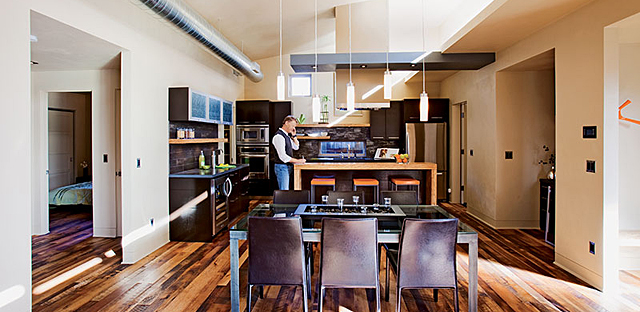sierraclub.org - sierra magazine - may/june 2010 - comfort zone


Comfort Zone | Smart Designs for Pleasure and Planet
Long-term Green
By Brian Libby

A "light shelf" reflects natural light from high windows deep into the house, showcasing reclaimed-lumber flooring.
"The house's interior finishes," says architect Dan Hill.
"The idea was to create a sustainable, loft-style look."
""In the 1990s and early 2000s, people wanted more space," Hill says. "Now we've made a change. The economy is part of the reason, but at the same time, you say, 'This is what I really believe in.'
"That's one of the things I love about walking in here," architect Dan Hill says, lifting his nose as he steps through the front door of the ultra-sustainable home his company designed and built in Eugene, Oregon. "It doesn't have that new-house smell or that new-carpet smell that's so toxic." There's no formaldehyde or volatile organic compounds hiding in this house.
On a gray, cool morning, a courtyard fountain percolates rainwater collected from an adjacent irrigation cistern. Inside, enough sunlight permeates the house's floor-to-ceiling windows to give the great room and kitchen a cinematic ambience. While the sunlight makes its way inside, the damp Northwest air doesn't stand a chance, thanks to high-efficiency insulation and windows.

A cistern collects rainwater for irrigation and a "rain pond" (left); exposed ductwork and a sliding panel that maximizes floor space create a loftlike feel (right).
Plenty of homes today claim varying degrees of sustainable design and construction. This one hits the top: It earned the U.S. Green Building Council's LEED platinum rating (the first in this eco-to-the-core university city of 146,000) and a higher score than any house west of the Rocky Mountains. Rooftop solar panels generate all of the home's power for as many as five months a year (and most of it year-round), while a separate solar system provides 70 percent of its water. Handsome redwood siding, reclaimed from a renovated outdoor amphitheater's benches, contrasts with industrial elements such as exposed ducts.
The house was developed by Hill's company, Arbor South, to demonstrate what's possible with contemporary green practices. At $459,000 for two bedrooms (and about 1,500 square feet), it's more expensive than comparably sized homes--until you figure in the future savings from next-to-nothing utility bills. That up-front premium during a pesky recession, though, means it has remained on the market since July 2009.
Still, Hill believes the house portends a shift in home building. "People are looking to have smaller, higher quality homes versus the McMansion concept," he says. "Our firm started 28 years ago doing small solar-powered housing. But we got away from that, like a lot of firms. This house is getting back to our roots."
ON THE WEB What's your idea of a green living or work space?
Tell us at sierraclub.org/sierra/shelter.
Photos, from top: Susan Seubert, Mike Dean (2)